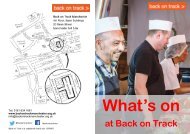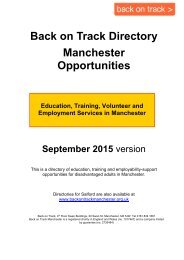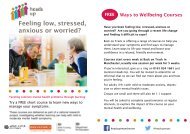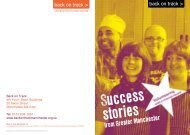newsletter online edition
You also want an ePaper? Increase the reach of your titles
YUMPU automatically turns print PDFs into web optimized ePapers that Google loves.
staying on track
A P R I L / M A Y 2 0 2 0
Stretching with Kate
RECIPES AND PUZZLES
LEARNING IN LOCKDOWN
MAKE YOUR OWN BIRDBOX
STAYING ON TRACK PAGE | 2
Mental Health Awareness Week
18th - 24th May
1 in 4 of us will experience a mental health issue. How do you look after your
mental health? What helps and what doesn't? Knowing the answers to these
questions is part of having a good awareness of how to stay mentally healthy.
According to research, there are 5 types of activities that, when done regularly,
can help us feel well. You may have come across this model in your Wellbeing
class at Back on Track!
The 5 Ways to Wellbeing
Ways to connect:
Call a trusted friend
Share your story
Send someone a postcard
Join a new group
Get to know someone better
Ways to take notice:
Try some meditation
List what you're grateful for
Notice how you feel today
Try a body scan exercise
Enjoy each moment
Ways to give:
Clap for the NHS every Thurs
Check up on your neighbour
Give someone a compliment
Start a charity box
Smile at someone
Ways to be active:
Try some yoga on YouTube
Walk around the park
Take the stairs (not the lift)
Do some gardening for 30 mins
Dance!
Ways to keep learning:
Look up a new word
Read for 10 minutes
Try the Peak Brain app
Ask questions & be curious
Do a puzzle or jigsaw
Build your own
wellbeing 'toolbox'
Having ideas or 'tools' to hand for your mental wellbeing is important.
Your task this week is to write down all of the ways that you could
connect, be active, give, keep learning and take notice using the
examples given above to start you off. Then, if you find you're not having a
great day, you can look at the list and pick an activity to try.
STAYING ON TRACK PAGE | 3
Join our 5K Challenge!
Have you been enjoying your daily walks? How about
pushing yourself a bit further? Let’s see how far we can
virtually walk and/or run as a community during lockdown!
Keep track of how many steps or miles you do each week and tell your allocated worker! We’ll tot up
the mileage and track how far our collective steps would take us. It takes 20 million steps to walk
around the world. There are almost 250 people in our Back on Track Community. If we all completed
2,666 steps a day (10-15 minute walk) during June we could make round the world once. Can we make
it around more than once?
How about trying a jog or run?
Taking up running can seem daunting,
especially if you feel out of shape or
unfit. Some of the staff team have
been using the NHS Couch to 5K plan
to help us to get started. The plan
helps you to gradually work up
towards running 5K in just 9 weeks.
Week 1 involves
running for just a
minute at a time - a
realistic and
achievable goal!
What is Couch to 5K?
Couch to 5K is a running plan for absolute beginners. Whether
you've never run before or if you just want to get more active,
Couch to 5K is a free and easy way of getting fitter and
healthier. It involves 3 runs a week, with a day of rest in
between.
How does Couch to 5K work?
One of the biggest challenges a new runner faces is not
knowing how or where to start. We can overdo it, feel
defeated and give up when we're just getting started. Couch to
5K works because it starts with a mix of running and walking to
gradually build up fitness and stamina.
What are the benefits?
Running requires little
equipment (but a good pair of
running shoes may help
improve comfort)
Running improves the health
of your heart and lungs
Running is a great stress
reliever and can even combat
depression
If you have any health
concerns about an
exercise challenge like
Couch to 5K, speak to
your GP for advice
I’m currently on week 5 by the
end of this week I should be able
to run for 20 minutes without
stopping (fingers crossed!) Every
week I think I won’t be able to do
it but I’m surprised every time I
manage to run for a bit longer
and I feel a massive sense of
achievement and I’m starting to
recover quicker (which apparently
is me getting fitter!) I’m starting to
feel some benefits, like; having a
bit more energy and motivation.
It’s free, it gets me out of the
house in the fresh air and I get to
listen to music and clear my mind
for a bit. Clare
STAYING ON TRACK PAGE | 4
Kate's Running Tips
1
2
3
4
5
6
7
8
If you’ve never run before, it will be difficult the first few
times. It’s normal to feel horrible and be out of breath as
your body isn’t used to running movements. Don’t give up, if
you continue to go out, you will improve!
5 minutes or 2 hours, EVERY run is better than nothing.
Even if you don’t feel like it, put your PE kit on anyway, you may just
go out after all. No matter how long or fast, give yourself a pat on the back!
New runners always start off running too fast. This will only result in your running out of
steam. SLOW DOWN! Even if it feels like you could walk faster, it’s important not to rush
like you are in a race. You can always speed up when you get fitter.
STRETCH BEFORE AND AFTER! It’s boring, but your body will thank you for it and it’s
likely you will be in pain if you don’t.
If you think you may like it, invest in a good pair of running trainers, they don’t have to cost
the earth. You can get all kinds of running clothes, but you only need decent trainers.
Try not to tense your body, let your shoulders relax, unclench your fists, don’t swing your
arms side to side, but try and swing them out in front (not too much) with your elbows in,
this will propel you forward.
If you have never run and don’t do a lot of exercise, even running a minute may seem
impossible, but if you continue training, YOU WILL be able to do this, and longer!
Lastly, NOTICE HOW YOU FEEL after a run, your body may feel in pain, but running is a
great way to produce endorphins, lifting your mood and helping maintain good wellbeing.
Rachel's running again!
I bought a running machine with the train fare not spent
travelling to work. I used to run many years ago but got well
out of the habit. I have had a bad knee for a while and this
made me even less mobile and I put on a lot of weight. I am
taking it slowly but my knee is holding it out and I'm really
enjoying listening to music and having 30 minutes to myself
(kids parked in front of Disney!). I feel happier and healthier
- if I can do this, anyone can! Rachel
STAYING ON TRACK PAGE | 5
Daily stretching with Kate
Regular stretching can increase blood and nutrient flow, making us feel
energised and more motivated. You may struggle with some of these exercises,
so listen to what your body is telling you and stop if you feel uncomfortable.
Take each stretch slow, there’s no rush!
Sun salutation
Stand straight, feet together, shoulders relaxed. Taking a deep breath,
reach up as high as you can, take your time! Wiggle your fingers when
you get to the top and when you feel you have had a good stretch, ‘flop’
and let your arms and head drop while breathing out.
Upper arm stretch
Standing or sitting, raise your arm up, grab the left arm
with the right and pull until you feel a good stretch in
your upper arm. Swap sides.
Sit down stretch
Sit on the floor if you can. Taking a deep breath, extend your arms
above your head, exhale and reach to your feet (don’t worry if you
don’t get there, touching your knees will do!).
Neck stretch
Sit down or standing up, take your left hand up and over your head to
touch your right ear and gently pull to stretch your neck. Then swap.
Again, do what you are comfortable with!
Tree pose
Stand straight, fix your gaze on a point to help with balance. Lift one knee
and try and place your foot just below the opposite knee (be careful to not
press your knee). Once you have your balance take three deep breaths.
STAYING ON TRACK PAGE | 6
Picture Perfect:
Photography with Paul
Welcome to our first photography feature, where we'll be sharing hints and
tips on how to get started in photography, or to improve your images
should you already be making photos. Photography can be done anywhere;
in your own home, on the streets of the city or in a park. It can be a great
motivator to go outside and to explore your local area, as well as being
a gentle form of exercise.
Creating your photo -
Tip 1: 'Rule of Thirds'
This is a simple but powerful technique that can
transform your photos straightaway
Used for centuries in paintings as a way of
creating balance in an image and making it
pleasing to the eye of the viewer
Cheetah
1 - Subject positioned along the left third, looking
right in to the space creating interest; what is it
looking at?
2 - Negative space in the right hand side of the
image
3 - Grass takes up the bottom third and the
background the top two thirds
Place your subject on one of the grid lines or
near to where the grid lines come together
Most phones and better digital cameras allow
you show the grid on your screen/viewfinder
Take a look at these examples:
1 2
3
1
2
3
Tree
1 - Grass is positioned in the bottom third leaving
the sky in the top two thirds
2 - Image is balanced with foreground (the tree)
and background subjects (the mountain)
3 - Tree is the main subject and is positioned on
the right hand third of the frame
Get inspired: Neil's story
Neil attended the Picture Perfect course at Back on Track and was inspired to
purchase a camera. Since lockdown, he has been out and about photographing
his local area. Neil's wonderful photo (right) uses Rule of Thirds and Leading
Lines to create a perfectly composed image, and the silhouette of the couple
make a great subject.
Neil says: 'The photography course at Back on Track guided me through each
stage and encouraged me to invest in my own camera. During the lockdown, this
has really helped me to get out of the house for my daily exercise, enjoy the nice
weather and explore local nature spots.' Well done Neil!
STAYING ON TRACK PAGE | 7
Photographing Your Walk:
Be Mindful
Now we're able to spend more time outside, make the most of it by being
more mindful of your surroundings. Photography can help with three of
the 'Five Ways to Wellbeing' - Be Active, Learn and Take Notice. The
following tips can make even the most visited location seem new and
interesting all over again, as well as helping you take more notice of the
world around you.
Find the right shade -
working with colours
Try this: On sunny days, colours can be bold and bright. On
your next walk, can you find colours that complement each
other? For example:
Yellow complements purple
Green complements red
Warm colours (e.g. yellow)
complement cool colours (e.g. blue)
Use the colour wheel (left) to help you.
Complementary Colours in Action
'This photo (right) was taken on my
walk along the Rochdale Canal. You
have the cool blue sky
complementing the warm yellow of
the shutters and the leaves on the
trees' - Paul
For your next walk:
Paul's top tips
Start observing without your phone or camera in your hand
Use conscious noting like: 'Hey, that looks interesting!'
Use more than just your eyes - what can you smell, touch, hear?
Look for interesting patterns and textures
Found something you want to photograph? Take out your
camera/phone and take your time composing the image. Try
different angles, get closer, get higher or lower
Finally, make your photo. Limit yourself to 3-5 photos on your walk.
This encourages you take your time and really think about what
you're photographing.
STAYING ON TRACK PAGE | 8
Reasons to Read
Remember that reading for just 10 minutes each day can improve
concentration, build resilience and reduce stress. Plus it's a great way to
escape for a little bit. Don't fancy a long novel? No problem! We have a
range of Quick Reads for your to choose from. Have a look below and just
let your worker know which one you'd like.
Feel The Fear and Do It Anyway by Susan Jeffers
Have you ever wanted to do something but found that fear stopped you from even trying?
Everyone has their own fears, and these can get in the way of us progressing and reaching for the
things we really want in life. This bestseller provides us with some tools to help deal with fear.
Forty-six Quid & a Bag of Dirty Washing by Andy Croft
Reading Group members, you may remember this one! Barry is looking forward to his first weekend
on the out. Free at last! He has nothing to lose but his £46 discharge grant, a bag of dirty washing,
and all the promises he has made to himself in prison...
Six Foot Tall by Kit De Waal
It's an exciting day for Timothy Flowers - it's his twenty-first birthday. When Timothy walks to his
usual street corner to see his favourite bus, he meets Charlie who needs his help. Things don't go
according to plan and over the course of one day, Timothy's life will change for ever..
In Your Own Words: Extraordinary Tales from Ordinary Life
Coincidences, unexpected reunions, strokes of luck or misfortune, all have the power to present
themselves to us at any time. This book brings together stories of ordinary people’s different and
unexpected experiences.
The Great Cornish Getaway by Fern Britton
A stranger arrives in the seaside village of Trevay in need of a safe haven. Penny & Dorrie both
know what it feels like to need a break so they promise to keep their stranger's secret. The fact
that the stranger is a Hollywood heartthrob makes them even more eager to help…
Fans by Niall Griffiths
Jerry is excited about taking his young son Stevie to watch the big match. But when trouble
breaks out between the fans, Jerry and Stevie can't escape the shouting, fighting and flying glass.
And then Stevie gets lost in the crowd. What will Jerry do next? And what will happen to Stevie?
STAYING ON TRACK PAGE | 9
It's growing season!
Summer is here and it's time to plant and watch things grow.
In this issue, we have given you some seeds to grow your
own sunflower! Don't worry if you don't have a pot or if
you've never planted anything before. It's easy - there's only
3 steps to follow. Read the instructions below to get started.
For this activity, you will need:
Sunflower seeds
A small pot
Handful of soil or compost
A few plastic bottles from your recycling bin
Step 1: Put some damp soil in your pot and fill it almost
to the top. Make a hole for the seed with your finger.
Step 2: Plant the seed in the hole and cover with some more
soil, about 1cm. Feed the soil with a cup of water.
Step 3: Keep the sunflower covered with the top half of a cut plastic bottle
(see pic 3). Put the cup on a sunny windowsill. Spray the soil with water whenever
it feels dry, usually every few days. In 1-2 weeks your plant should pop up through
the soil - plant outside in a sunny spot.
Top tips for growing
Plant only one seed per pot
1 2 3
No pot? No problem! Instead you could
use: a plastic party cup, fizzy drink bottle/can
or milk carton cut in half. Just make sure you
poke a hole in the bottom
Prepare a bigger pot for your sunflower
as they very grow fast!
STAYING ON TRACK PAGE | 10
Learning in lockdown
Our summer term courses would usually be due to start next week, so if you can why not
trying learning from home? Artists, chefs, fitness instructors and teachers are all staying
safe at home too. They are sharing more and more free content on YouTube and other
social media. There are cooking sessions, language classes, arts and crafting lessons,
exercise, meditation and much more. Our tutors have picked out some of their favourite
YouTube videos and websites to enable you to enjoy your favourite subjects from home.
health and wellbeing
Kate recommends www.headspace.com - 'I love this website dedicated to
mindfulness, Free and easy to use! And also the Happy Place podcast presented
by Fearne Cotton, who interviews people about their quest for happiness.
Inspiring and thought provoking!'
Katie recommends Yoga Beginners by Sarah Beth
'I have practised this yoga sequence pretty much
every single morning for over a year. I have seen
significant changes in my mood and my body is
much stronger. It makes for a refreshing and
energising start to your morning. Practise every day
and you’ll soon find you don’t even need to look at
the video. Includes very simple stretches and good
for beginners.'
Search '10 minutes morning yoga
for beginners' on YouTube
finding recipies online
Caron recommends cookingonabootstrap.com -
'One of the best websites I know for cooking delicious
meals on a budget. I use these recipe ideas in our Back
on Track cookery courses. I also recommend Jamie
Oliver's Keep Cooking and Carry On - some brilliant
recipes here - cheap and delicious. Just go to
jamieoliver.com and there's a link on the home page.'
STAYING ON TRACK PAGE | 11
Jay's quick
cupboard soup
Swan Kitchens volunteer Jay loves trying out
different soup recipes in the cafe. Why not try this
one out at home?
Ingredients
1 x tin of tomatoes
1 x tin of baked beans
1 x veg stock
Pinch of mixed herbs
1 x clove of garlic finely chopped
Pinch of chilli flakes
Salt and pepper
1 x onion finely chopped
1 x tablespoon of ketchup
1 x teaspoon of sugar
Method
1. Chop onions and lightly fry.
2. Add, garlic and chilli flakes
3. Mash the tomatoes with a fork
4. Add ketchup, the tomatoes, baked beans and
mixed herbs
5. Take a mug of hot water and dissolve stock
cube
6. Add stock to beans and tomatoes and simmer
for 10 mins
7. Either blend or mash till smooth
8. Add salt and pepper to taste·
9. Serve with bread and butter
10. Enjoy!
Make a bird box using a milk
bottle carton
Cut a circle in each milk carton (cut one out of
paper first then trace it onto the carton)
Paint the milk cartons with white paint and
let it dry
Get creative - decorate in any way you like
(paint/tissue paper like in the picture)
Cut a little slit and push a stick through (twig,
lolly pop stick or wooden spoon)
Make a hole and thread through some wool or
string to use for hanging
Fill with seeds for birds to enjoy
Hang your box
TIP – varnish your bird box to protect it
STAYING ON TRACK PAGE | 12
Caron's homemade bread
Cooking can be a great stress-buster. Why
not look at the contents of your fridge,
freezer or cupboard and use it as an
opportunity to be brave and childlike.
Experiment! Rule nothing out! This recipe for
bread has only four ingredients so do try it
out if you can. It doesn't matter if doesn't
come out perfectly - just relax, take your
time and enjoy the process!
Ingredients
500g strong white or brown flour
2 teaspoons of salt
3 tablespoons of oil
1 sachet or 7g dried yeast
300ml of warm tap water
Mix flour yeast and salt together
Add oil to water
Add liquid to flour, yeast and salt mix well
Tip mix onto a lightly floured surface
Knead until satin soft
Place in a lightly oiled bowl and let it rise for one hour
Knock back dough (punch air out of the dough)
Mould gently into a ball and place in a greased loaf tin or a
baking sheet lined with greaseproof paper
Leave to double in size
Heat oven to 220C fan, 200C or gas 7
Bake for 25-30 mins. Loaf should be golden
brown and sound hollow when tapped on
underneath
No yeast? No problem! Make your own!
1. Put 200g each of both lukewarm water and any
type of grain-based flour into a container – leave
room for your mixture to grow.
2. Store it somewhere warm overnight - uncovered
3. The next day get rid of half the mixture and add
another 100g of both water and flour
4. Repeat this process every day until you see
bubbles appear
5. Use this mixture instead of yeast with our recipe!












